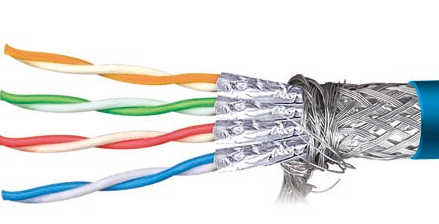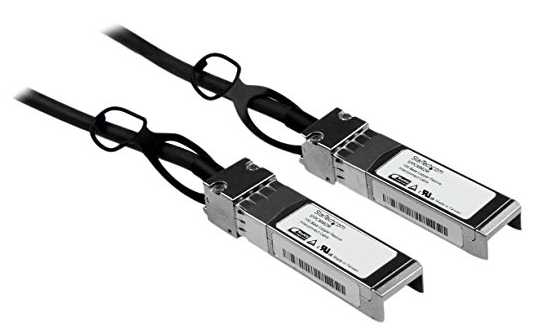Those of us who have used RJ45 cables for Ethernet have a tendency to want to use something similar when we’re considering an upgrade to 10GigE. It turns out using a “10GBaseT” card and the standard RJ45 connector based twisted pair patch cable might be the wrong choice. Although 10GBaseT with RJ45 connectors are fairly common, they tend to run hotter due to the amount of current drive required to push these high speed signals over twisted pair wiring. Also, when using even newer style “Cat 6E” cable the lengths can be limited to 55 Meters (Note Cat 7 pushes the maximum length to the standard 100 Meters for Ethernet). From this you can infer there will be more dropped packets and in general more cabling problems could occur when using 10 Gigabit signaling over twisted pair wires. Things like sharp bends in the cable (staples holding them to the wall) or untwisting pairs to put connectors on can become critical to reliability of the signal. Cat 7 Cable has both twisted pairs, as well as shielding around each pair and a braid around the entire cable. As such this cable is both expensive and harder to use with DIY cable crimpers. 
Spend a little time looking at 10GigE because there are several other options, although they can be confusing. Many of the common 10GigE card and switches have SFP+ interfaces that may require purchasing additional “Tranceivers” or GBICs. GBICs plug into SFP+ slots and can provide physical connections for fiber or copper. If you just want an easy and inexpensive connection and your switch is in the same rack as your 10GigE device, consider purchasing a low cost SFP+ to SFP+ twinax cable. These are “passive” cables (no electronics) that may give you the easy connectivity you’re looking for. Be aware these cables are limited to short distances – 3M to 7M seems to be the common but Wikipedia suggests 15M is the limit (see below).
Here is an HP switch with 4 optional SFP+ slots. As an option to buying “tranceivers” you may be able to just use the cable pictured above.
 Conclusions: 10 Gigabit Ethernet has many connector options (Fiber and copper). For example an “SR” Tranceiver would be used for short reach fiber connections. an “LRM” Tranceiver would mean Long Reach Multi-mode. Fiber is sold as either single-mode or multi-mode. The wavelength of the fiber and the types of connectors used should be studied carefully to match the Tranceiver that you purchase. Take a look at this wikipedia chart to see the various types of physical interfaces and click over to the Wikipedia article (link to learn more
Conclusions: 10 Gigabit Ethernet has many connector options (Fiber and copper). For example an “SR” Tranceiver would be used for short reach fiber connections. an “LRM” Tranceiver would mean Long Reach Multi-mode. Fiber is sold as either single-mode or multi-mode. The wavelength of the fiber and the types of connectors used should be studied carefully to match the Tranceiver that you purchase. Take a look at this wikipedia chart to see the various types of physical interfaces and click over to the Wikipedia article (link to learn more ). Use fiber for lower power operation and running greater distances. Use copper for shorter connections where running fiber isn’t an option. All options run at the same speed.
). Use fiber for lower power operation and running greater distances. Use copper for shorter connections where running fiber isn’t an option. All options run at the same speed.



